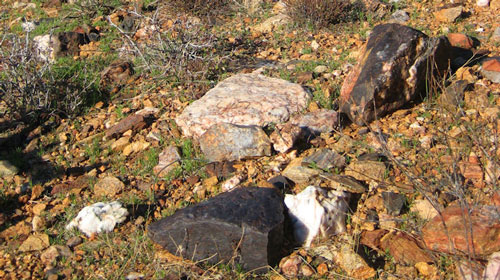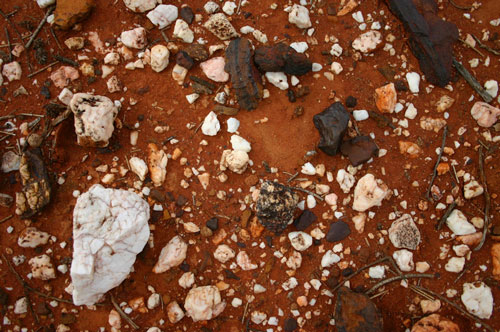Persons new to the hobby of metal detecting will probably realize fairly quickly that it isn't just the ground that can cause false signals. There are other things lurking in the goldfields that can be just as noisy; namely the dreaded hot rocks!
A hot rock can loosely be defined as: any rock or stone not containing a valuable mineral (gold, silver, or copper) which generates an audible signal response on a metal detector. The exact cause of this phenomenon has been debated among detectorists for some time. Numerous theories have been proposed, however those that seem most reasonable to me are the ones that focus on the iron-bearing minerals found within most hot rocks. These minerals are predominately the iron oxides: magnetite, hematite, limonite, maghemite and lepidocrocite. All of these oxides exhibit a varying degree of ferromagnetism and can be magnetized by being exposed to another magnetic field; like the one generated by a detector's search coil. If the coil is swept across a high iron content hot rock, a secondary magnetic field will be created around it. This secondary field will then be sensed by the coil's primary field and trigger an audible response via the headphones or speaker.
 Negative hot rocks, such as these above, are found in many goldfields around the world.
Negative hot rocks, such as these above, are found in many goldfields around the world.
Just like gold nuggets, hot rocks seem to come in a never ending assortment of shapes, color and sizes. The typical varieties you are likely to encounter in the US are basalt, magnetite and hematite. There are many others, but these are the most common. A variety of classification schemes and names have been proposed for the hot rocks that litter the goldfields. These names include cold rocks, hot rocks, positive rocks, negative rocks, etc. Personally, I have always tended to use the terms positive and negative when referencing hot rocks.
Negative hot rocks are usually magnetite or contain magnetite. They tend to be dark in color and are often heavy due to their iron content. They are usually attracted to a magnet and in some cases, will show rust stains.
Positive hot rocks are usually iron-bearing rocks which have been oxidized by natural weathering processes. They are typically small in size and found up towards the surface. They are most often reddish in color, but can also be black, brown or even yellow. Positive hot rocks are not always attracted to a magnet.
Positive hot rocks are the most troublesome since the signal they produce most closely resembles a piece of metal. These variety produce a distinct “zip-zip” and can often be picked up several inches deep. Many sound exactly like a nugget, and practice will be needed in order to learn how to sort them out from the real thing.
 Example of highly mineralized ground containing both positive & negative hot rocks.
Example of highly mineralized ground containing both positive & negative hot rocks.
Negative rocks, on the other hand, produce more of a “boing” sound. They are easier to deal with because the signal they generate differs considerably from that of a gold nugget. As the search coil is passed over them the threshold momentarily goes quiet, then the “boing” sound is heard. I have noticed that they can be difficult to pinpoint and at times, they seem to move around. You may also find that they will only sound off in one direction. In other words, a signal will be heard on the forward swing of the coil, but not the back swing. If this occurs, and the signal is not repeatable both ways, then the target is likely to be a hot rock.
In part 2 of this blog post I'll present ways to deal with hot rocks when prospecting.
See you on the goldfields!
Chris Gholson Arizona Outback - Minelab Authorized Dealer




















Comments